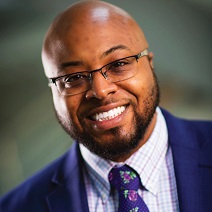
Summer 2020
From Personal Health to Pandemics, Police Brutality, and Protests – A Vision for Black Men’s Health Equity in 2020
Tiffany L. Carson, PhD, MPH✉; Aldenise Ewing, PhD, MPH, CPH✉; Betina Yanez, PhD✉; Health Equity SIG


Derek Griffith, PhD, and Charles Rogers, PhD, MPH, MS, CHES
June is Men’s Health Month. However, in a time when Black men must decide between wearing a mask to lower the risk of spreading or contracting COVID-19 or not wearing a mask to lower their risk of being seen as a threat or a criminal, achieving racial health equity must be a part of the 2020 conversation on men’s health.
Racial disparities in men’s health are well documented. For example, prostate cancer occurs more often among Black men and Black men are more likely to die of prostate cancer when compared to white men.1,2 Black men also have a higher prevalence of hypertension and incidence of stroke than their white counterparts.3-5 These differences are largely driven by social determinants of health including access to quality health care, chronic stress, cultural mistrust of the health care system, and unfavorable environmental conditions. However, when we layer systemic racism and oppression on top of a legacy of unfavorable societal conditions, achieving optimal health and quality of life for Black men may seem like a daunting challenge.
While inequities among Black men have recently come to the attention and consciousness of many due to current events like the COVID-19 pandemic and killings of Mr. George Floyd and Mr. Ahmaud Arbery, experts like Derek Griffith, PhD, and Charles Rogers, PhD, MPH, MS, CHES, have dedicated their careers to addressing men’s health issues. Dr. Griffith is Professor of Medicine, Health and Society, and he is the Founder and Director of the Center for Research on Men’s Health at Vanderbilt University. Dr. Rogers is an Assistant Professor in the Division of Public Health at the University of Utah School of Medicine, an Associate Member at the Huntsman Cancer Institute, Founding Director of the Men’s Health Inequities Research Lab, and an Associate Member of the Michigan Mixed Methods Program. Below, they lend their perspectives on a vision for achieving Black men’s health equity.
What do you think are existing challenges in achieving equity in men’s health outcomes?
Dr. Griffith: The biggest challenge in achieving equity in men’s health outcomes is the fact that few policies or programmatic strategies take into account both the gendered and non-gendered factors that are obstacles to health equity and optimal health. For example, most strategies consider race and sex/gender separately and do not consider how these factors intersect. The second biggest challenge is that most data used to evaluate programs and policies similarly separate race and sex but do not consider the intersection of the two to determine if race by sex/gender groups fare differently than considering either factor alone. The third challenge I will mention is that we tend not to consider the full range of determinants of health are gendered and racialized in our conceptions of the problems or in our policy or programmatic interventions.
What recommendations do you have for translating research into policy?
Dr. Griffith:
- Offer recommendations for policy that are actually within the purview of policy makers. While we can always suggest that more research is needed and we need more funding for research, it is important that we provide guidance about where funding should be allocated, protections should be offered, and regulations should be revised.
- Strengthen data sources and refine strategies to use and present data that align with our need to identify the populations with the worst health outcomes. Some determinants – like sex/gender – operate in ways that may be counterintuitive yet are consistent with data.
- Pay attention to the way that we frame problems and solutions for populations of interest. One of the biggest challenges with men’s health promotion is that many believe that men’s poor health is rooted primarily in men’s notions of masculinity or manhood and not in the larger societal structures that impede other efforts to achieve equity.”
What have your experiences been in achieving the translation of research into policy?
Dr. Rogers: I have fostered interdisciplinary relationships with academics, physicians, advocacy organizations, and community members to become a respected leader focused on achieving health equity and improving the health of underrepresented groups. Owing to advocacy efforts and research, my contributions informed the Cancer Plan Minnesota 2025, and also encouraged two Minnesota senators to introduce legislation addressing colorectal cancer and health disparities among American Indians and African Americans.
Given the current climate of our society, what are some important actions that we can take now in working to achieve health equity for men?
Dr. Rogers: Coronavirus disease 2019 (COVID-19) has made it even more challenging to achieve health equity as COVID-19 has emphasized how health disparities are extensive for communities of color who battle numerous social determinants of health (e.g., racism, health insurance, economic stability, food security). Better understanding the prominence of these economic and social factors is key to assuring all men are able to live the healthiest life possible no matter how much money they make, what race they self-identify as, nor where they live, work, play, and worship. Actionable steps include: 1) assuring men from racial/ethnic minority groups are amply represented in clinical trials, 2) implementing theory-based interventions and policy change to assure bias is reduced in health care settings, 3) increasing workforce diversity, 4) partnering with community organizations aiming to achieve health equity, 5) challenging institutional racism by disassembling norms preserving race-based gain, 6) endorsing and supporting paid family leave for men, and 7) expanding Medicaid and/or investing in universal healthcare.
References
- Rebbeck TR. Prostate Cancer Disparities by Race and Ethnicity: From Nucleotide to Neighborhood. Cold Spring Harbor perspectives in medicine. 2018;8(9).
- U.S. Cancer Statistics Working Group. U.S. Cancer Statistics Data Visualizations Tool, based on November 2018 submission data (1999-2016): U.S. Department of Health and Human Services, Centers for Disease Control and Prevention and National Cancer Institute; www.cdc.gov/cancer/dataviz, June 2019.
- Heron M. Deaths: Leading Causes for 2016. National vital statistics reports : from the Centers for Disease Control and Prevention, National Center for Health Statistics, National Vital Statistics System. 2018;67(6):1-77.
- Fryar CD, Ostchega Y, Hales CM, Zhang G, Kruszon-Moran D. Hypertension prevalence and control among adults: United States, 2015–2016. NCHS data brief, no 289. Hyattsville, MD: National Center for Health Statistics. 2017.
- Howard VJ, Madsen TE, Kleindorfer DO, et al. Sex and Race Differences in the Association of Incident Ischemic Stroke With Risk Factors. JAMA Neurol. 2019;76(2):179–186. doi:10.1001/jamaneurol.2018.3862